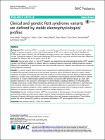| dc.contributor.author | Tropea, Daniela | |
| dc.contributor.author | Reilly, Richard | |
| dc.date.accessioned | 2019-09-02T15:20:42Z | |
| dc.date.available | 2019-09-02T15:20:42Z | |
| dc.date.issued | 2018 | |
| dc.date.submitted | 2018 | en |
| dc.identifier.citation | Keogh, C., Pini, G., Dyer, A.H., Bigoni, S., Dimarco, P., Gemo, I., Reilly, R., Tropea, D. Clinical and genetic Rett syndrome variants are defined by stable electrophysiological profiles, BMC Pediatrics, 2018, 18, 1 | en |
| dc.identifier.other | Y | |
| dc.identifier.uri | http://hdl.handle.net/2262/89393 | |
| dc.description.abstract | Background: Rett Syndrome (RTT) is a complex neurodevelopmental disorder, frequently associated with epilepsy.Despite increasing recognition of the clinical heterogeneity of RTT and its variants (e.g Classical, Hanefeld and PSV (Preserved Speech Variant)), the link between causative mutations and observed clinical phenotypes remains unclear. Quantitative analysis of electroencephalogram (EEG) recordings may further elucidate important differences between the different clinical and genetic forms of RTT. Methods: Using a large cohort (n= 42) of RTT patients, we analysed the electrophysiological profiles of RTT variants(genetic and clinical) in addition to epilepsy status (no epilepsy/treatment-responsive epilepsy/treatment-resistant epilepsy). The distribution of spectral power and inter-electrode coherence measures were derived from continuous resting-state EEG recordings. Results: RTT genetic variants (MeCP2/CDLK5) were characterised by significant differences in network architecture on comparing first principal components of inter-electrode coherence across all frequency bands (p< 0.0001). Greater coherence in occipital and temporal pairs were seen in MeCP2 vs CDLK5 variants, the main drivers in between group differences. Similarly, clinical phenotypes (Classical RTT/Hanefeld/PSV) demonstrated significant differences in network architecture (p< 0.0001). Right tempero-parietal connectivity was found to differ between groups (p=0.04), with greatest coherence in the Classical RTT phenotype. PSV demonstrated a significant difference in left-sided parieto-occipital coherence (p= 0.026). Whilst overall power decreased over time, there were no difference in asymmetry and inter-electrode coherence profiles over time. There was a significant difference in asymmetry in the overall power spectra between epilepsy groups (p= 0.04) in addition to occipital asymmetry across all frequency bands. Significant differences in network architecture were also seen across epilepsy groups (p=0.044). Conclusions: Genetic and clinical variants of RTT are characterised by discrete patterns of inter-electrode coherence and network architecture which remain stable over time. Further, hemispheric distribution of spectral power and measures of network dysfunction are associated with epilepsy status and treatment responsiveness. These findings support the role of discrete EEG profiles as non-invasive biomarkers in RTT and its genetic/clinical variants. | en |
| dc.language.iso | en | en |
| dc.publisher | BMC | en |
| dc.relation.ispartofseries | BMC Pediatrics; | |
| dc.relation.ispartofseries | 18; | |
| dc.relation.ispartofseries | 1; | |
| dc.rights | Y | en |
| dc.subject | Rett syndrome | en |
| dc.subject | MeCP2 | en |
| dc.subject | CDKL5 | en |
| dc.subject | EEG | en |
| dc.subject | Network | en |
| dc.title | Clinical and genetic Rett syndrome variants are defined by stable electrophysiological profiles | en |
| dc.type | Journal Article | en |
| dc.type.supercollection | scholarly_publications | en |
| dc.type.supercollection | refereed_publications | en |
| dc.identifier.peoplefinderurl | http://people.tcd.ie/reillyri | |
| dc.identifier.peoplefinderurl | http://people.tcd.ie/tropead | |
| dc.identifier.rssinternalid | 205802 | |
| dc.identifier.doi | http://dx.doi.org/10.1186/s12887-018-1304-7 | |
| dc.rights.ecaccessrights | openAccess | |
| dc.identifier.orcid_id | 0000-0001-8578-1245 | |




